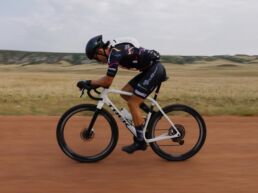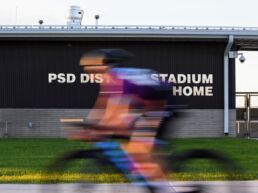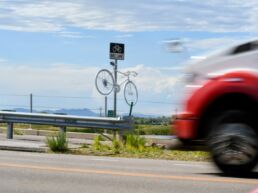 By Dr. Matthew Skrdla
By Dr. Matthew Skrdla
As you may recall, in my previous article posted to YGR, I discussed three critical vision skills for safe cycling: 1) Dynamic Visual Acuity; 2) Visual Information Processing; and 3) Peripheral Awareness. The first topic I briefly covered was Dynamic Visual Acuity (DVA). In this article, I will go into greater depth on what DVA is, how you can test your DVA, and I will give you a couple of exercises you can do to improve your DVA.
We typically think of Visual Acuity in reference to static clarity of vision. The term 20/20 vision, for example, refers to visual acuity. DVA starts with clear static visual acuity. If your vision is not clear while sitting still, it will only be worse while you are in motion. So, if you have not had your vision checked recently, start with that before worrying about DVA.
Dynamic Visual Acuity (DVA) refers to a cyclist’s clarity of vision while in motion or while tracking a moving object. Both of these happen at a rapid rate while cycling: the cyclist in motion, and the cyclists around you in your group, cars passing you and coming towards you, and the occasional dog chasing you!
As a skill, DVA allows an athlete to quickly send clear and precise information to the brain. The more clear and precise the details, the easier it is for our brain to process the information efficiently and the faster the brain is able to process that information and generate the correct physical movement.
DVA is critical to improving reaction speed. A study performed by Dr.’s Stine, Arterburn and Stern indicates athletes have higher functioning DVA than non-athletes. They also found that elite athletes have even higher functioning DVA than amateur athletes. This and other studies demonstrate the trainability of our own DVA.
So, what should athletes do to improve their Dynamic Visual Acuity skills?
First, try to assess your own DVA. Here is a link to a simple way of determining if your vision is compromised while you are in motion (http://www.sportsvisionmagazine.com/training/vision/dva003.html). Realize, even though they are using an eye chart during the video, you could easily use a stationary target like numbers on a clock or your TV guide channel.
Following are a couple of exercises which require the athlete to maintain visual focus on a target while in movement, and to maintain visual focus on a moving target and will help to train dynamic visual acuity:
$11) Jumping Visual Acuity – this exercise is meant to use an exercise trampoline and a visual acuity chart. While jumping on the trampoline, the athlete calls out letters on a chart.
$1a. Cycling Specific Application – in a safe environment such as a park, ride in the grass which will be slightly bumpy. Locate a sign and read the individual letters on the sign backwards while riding. Increase speed as you gain confidence
$1 i. Note: this exercise directly relates to mountain biking skills
$12) Letter Ball Bounce – this exercise was made famous by All Pro wide receiver Larry Fitzgerald whose grandfather is a Sports Vision pioneer. Tape, glue, or write letters and numbers on a ball. The letters and numbers should be of different size and color. Bounce the ball off the ground or a wall and call out the letter or number that is on the ball immediately after it bounces. As you gain confidence, spin the ball as you throw it and throw it faster or harder.
$1a. Cycling Specific Application This exercise relates to cycling in a group as you have to rapidly change focus from the cyclist directly in front of you, to the cyclist in front of the pack, and back to the road to scout for road hazards. Better be quick!
$13) GoPro and other Dynamic Video – While viewing your GoPro video, try to read details of your subject (such as  the name on a jacket, jersey,or a trail sign, etc.) This works incredibly well to develop this skill as it closely simulates your cycling environment.
the name on a jacket, jersey,or a trail sign, etc.) This works incredibly well to develop this skill as it closely simulates your cycling environment.
$14) Nike Strobe Glasses – here is a link to a ‘re-invented’ pair of strobe glasses that an athlete can practice with in their specific sport environment: http://nikestrobegoggles.com
If you have any questions regarding this or the prior article, feel free to contact me directly at matthewskrdla@gmail.com. Please place ‘Cycling Vision’ or something similar in the object field so that I will know it’s not spam.
Happy Riding!






